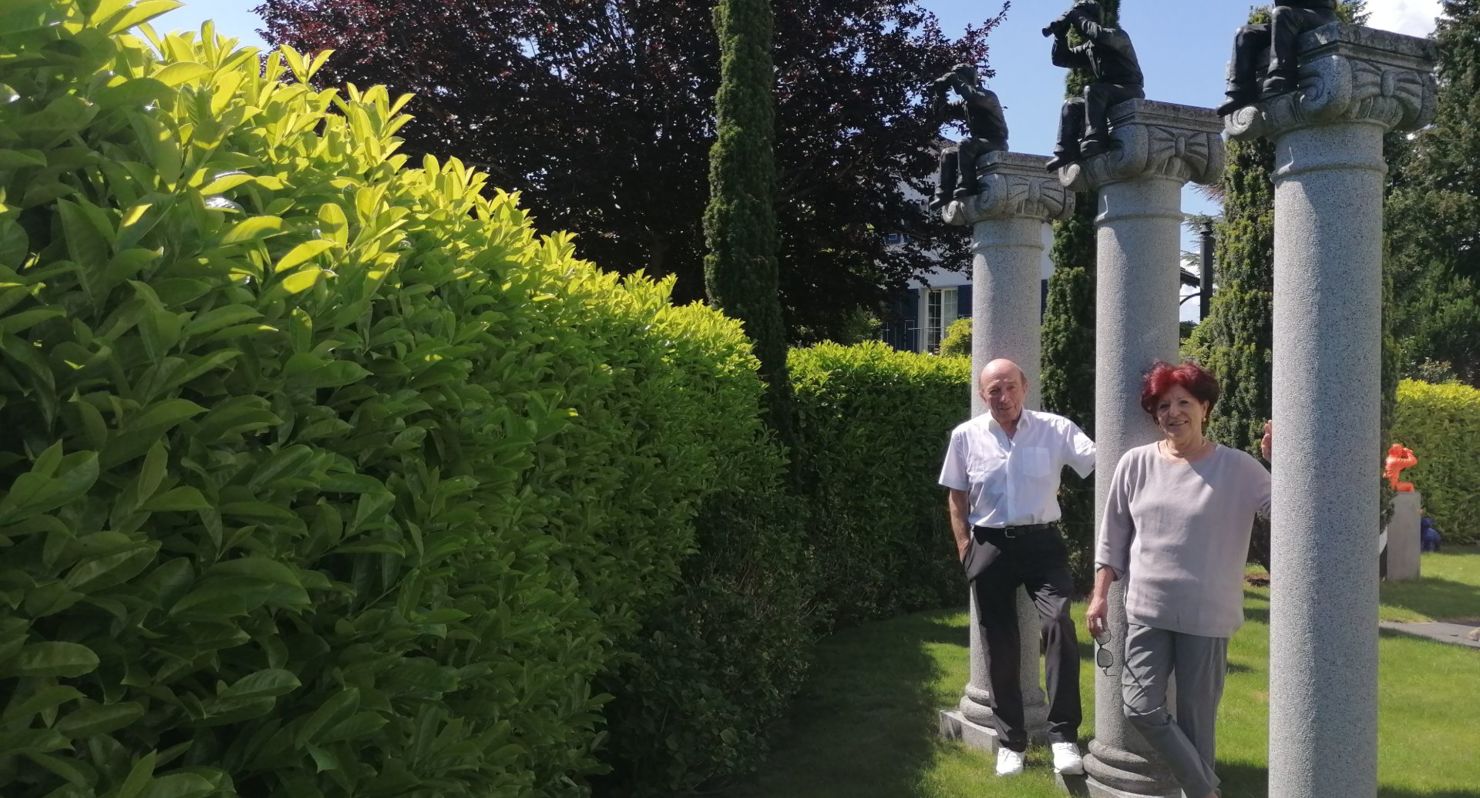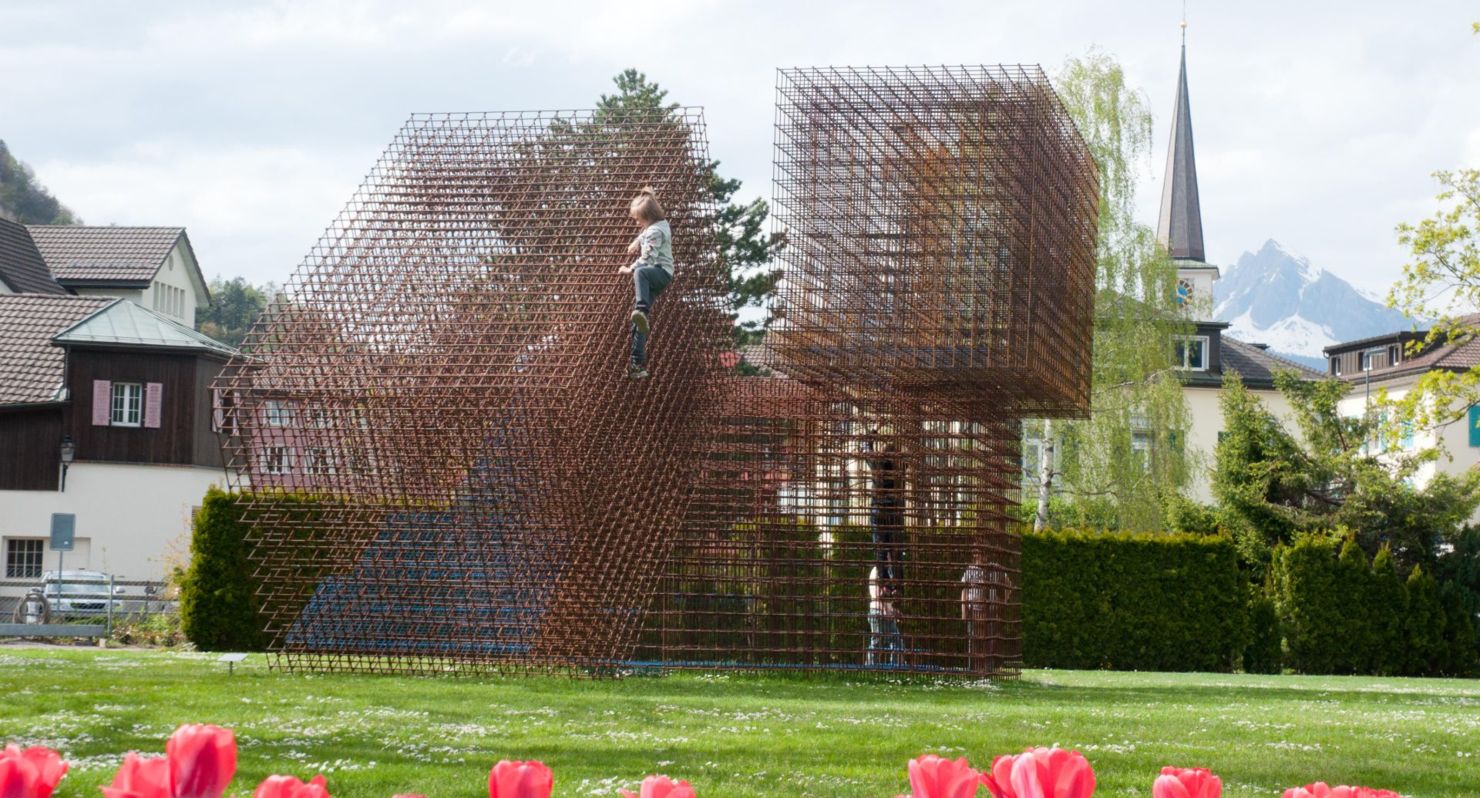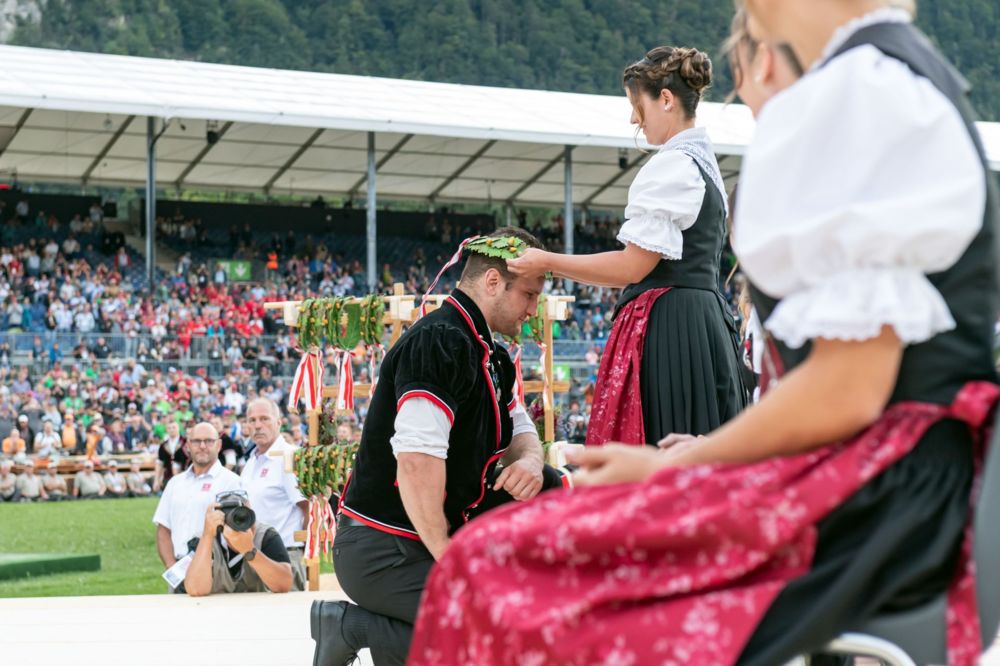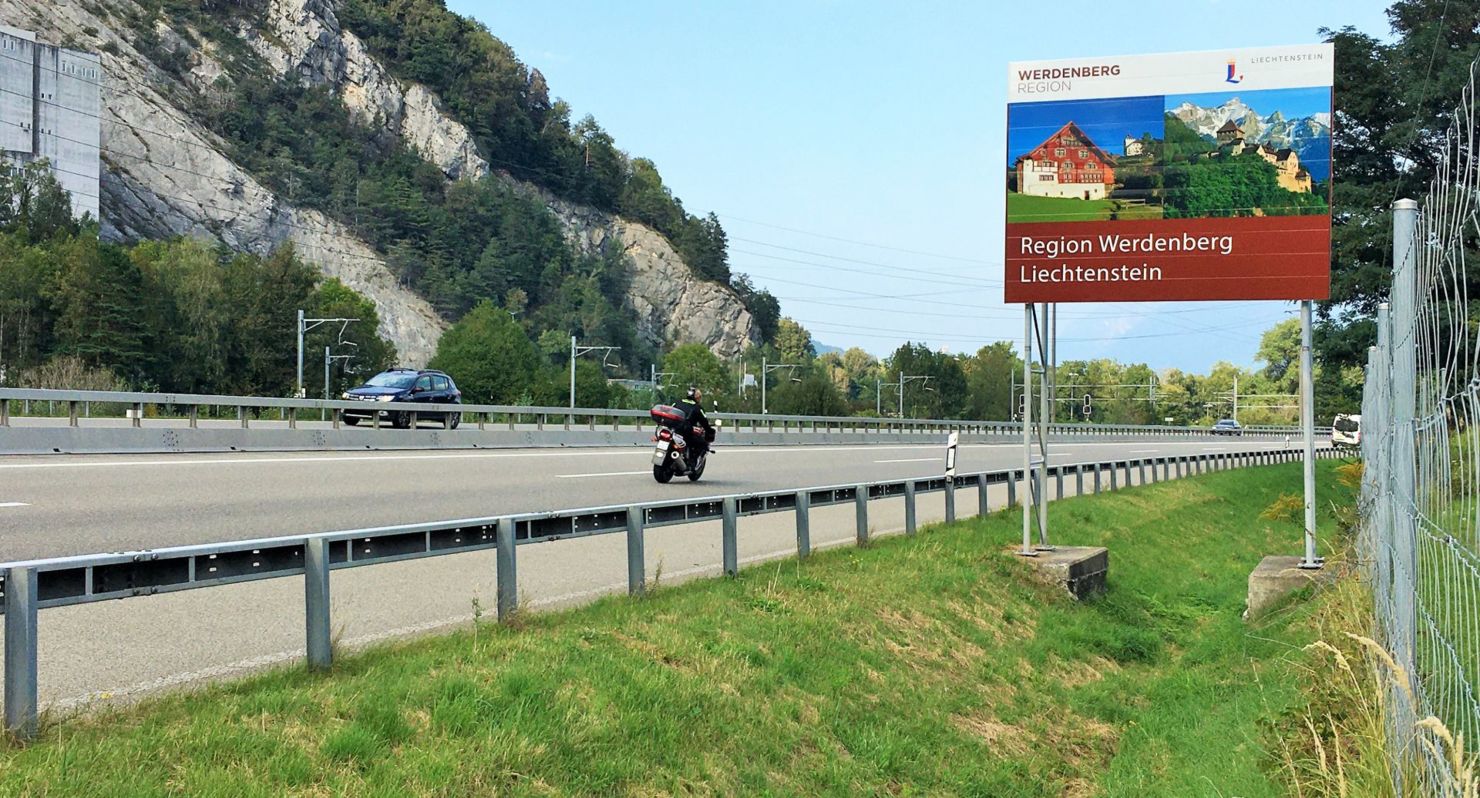Bad RagARTz – When distance sharpens the view





Bad RagARTz – When distance sharpens the view
They sit on a column and peer over the garden hedge with their binoculars: the black plastic figures of the German artist Ottmar Hörl. These world viewers show from far that the creators of Bad RagARTz - visionaries - live behind the large hedge. I park my car in the driveway and catch a glimpse of the open garage. It is full of boxes, orange exhibition magazines are piled up. Everything indicates that Esther and Rolf Hohmeister do a lot of the work for Bad RagARTz themselves. I ring the bell and wait excited to finally meet the multi-award-winning elderly couple in person. Rolf, dressed in suit trousers, white shirt and sneakers, opens the door for me with a wide smile and welcomes me warmly. Esther, dressed in elegant shades of grey, has just come out of the kitchen and offers me coffee. Together they lead me into their large garden, which is itself a small sculpture exhibition.
"Two risk-taking weirdos"
Bad RagARTz has grown from a small private exhibition in 2000 to an internationally respected sculpture exhibition. This year, the Swiss Triennial of Sculpture is taking place for the 8th time. Around 80 artists from almost 20 countries are exhibiting over 400 works of art - a total of 2500 tonnes of art. Around 500 000 visitors are expected during the five months of the exhibition. "Did you expect your art exhibition to cause such a sensation one day?", I ask and pull out my notebook. Esther and Rolf look at each other and laugh: "No, definitely not!". Rolf adds: "When we organised the exhibition on our own 20 years ago, we were considered two risk-taking weirdos!".
The sculpture exhibition, he says, was both a gift to the people and a protest against the authorities. "A lot of people were talking, but nobody was doing anything to breathe new life into the outdated spa town of Bad Ragaz. That's why we took it on." Rolf, a respected doctor, has always been interested in art." For me, art is a tool to teach people about culture," he explains. "And I was happy to jump on the bandwagon," adds his wife Esther, a family mother and poet, "We had our breakthrough at the third exhibition when the Grand Resort pledged its support. Since then, more and more organisations have supported us." Rolf adds with a more serious expression, "But in fact the contribution and interest from the region itself is probably higher."
The optimistic garden gnome
I ask the next question in my notebook, "Do you have a favourite character?". Esther laughs, "Everyone asks us that!". We have 450 favourite sculptures," Rolf jokes, "but if I had to limit myself to one now, it would be the optimistic garden gnome - that's the one that comes closest to us." Rolf points to a small orange plastic figure that shows the Ok thumb and stands in a transparent plastic bag in the middle of the garden. Esther seems to be able to read my question marks in her head: "The figure is by Ottmar Hörl. He brought us the figure wrapped in plastic - as a symbol that Switzerland has sealed itself off by rejecting the EU Framework Agreement." I had already read a lot about Esther and Rolf knowing the artists personally and even counting some of them as family, Ottmar Hörl seems to be one of them.
"What's the deal with this garden gnome?" I ask. Rolf tells me that they put 50 such gnomes out in Bad Ragaz to please passers-by and draw attention to the art exhibition. Later I read in the orange exhibition magazine that the garden gnomes are currently conquering the world as "Hörl's successful model". The magazine quotes the artist as follows: "People would never identify with a garden gnome. From this distance, he becomes a kind of representative in society. In fact, he never comes too close. That's why you can accept him as an acting proxy for something. The gnome functions as a mediator, we are reminded that these gestures have a connection to us in terms of content after all."
Distance sharpens the view
Distance plays a major role at the 8th Swiss Triennial of Sculpture in Bad Ragaz. The motto is "Distance sharpens the eye". "Did the current Corona pandemic inspire you to choose this motto," I ask. "No, even though it's hard to believe: we already decided on the motto in 2019 before Corona," Esther replies, "But how appropriate the motto really is turned out to be during the pandemic." "Did you guys never actually consider cancelling Bad RagARTz because of the Corona measures?" "No, we were sure pretty early on that we would hold Bad RagARTz as an exhibition despite the pandemic," says Rolf, "Sure, it suits us that the artworks are outdoors. But even so, we would have made an effort to be able to hold the event - if only because of the many artists who suffered so much loss because of Corona." Esther adds, "But we also realised the exhibition for ourselves and everyone else who longs for freedom and finally wants to experience something great again - of course always in compliance with the protective measures."
At that moment the phone rings. Esther excuses herself and goes into the house to make a call. In the meantime, I ask Rolf what the motto means exactly. He answers: "I like to compare distance with human respect. If you keep your distance, you can create closeness. It's the same in art. Sculptures often have a better effect from a certain distance, awaken a different feeling, touch differently". Rolf has hardly answered my question when Esther stands in the doorway of the terrace, beaming. "I have just sold a sculpture," she tells me joyfully. "Which one?" I ask curiously. "The marble drop by the German artist Reiner Seliger," Esther replies, "You'll see it right away on the tour with Rolf.
Art around the Grand Resort Bad Ragaz
Unfortunately, the Piaggio with which the Hohmeister family normally offers such exclusive tours is currently being serviced. Rolf therefore drives me in his car to the Grand Resort Bad Ragaz. There he has ordered a golf cart to visit the exhibition. While we wait for the key, Rolf points to the roof of the Grand Resort. There lies an oversized light bulb made of stainless steel and Plexiglas by the German artist Lydia Oermann. In the middle of the forecourt is an old wooden ladder by Italian artist Ivan Lardschneider, leading to nowhere. "Both are meant to stimulate thought, to show how well we are doing here," Rolf explains and gratefully accepts the key from the portière. We get in and drive to the front courtyard of the Grand Resort, where there is a large lawn with a variety of art objects. Rolf enthuses: "Nature and landscape are the siblings of art, how beautifully they are united here."
It is a weekday, the thermometer is scraping the 30-degree mark. Nevertheless, numerous visitors - individuals, groups, families - stroll through the dense collection of artworks. In the middle of it all, Rolf and I in our "Art Mobil". Among other things, we pass the two concrete sandpipers by German artist Christel Lechner, huge wooden book towers by Swiss artist Daniel Eggli and the aluminium pinball faces by Spanish artist Samuel Salcedo. Rolf stops at a collection of fibreglass balls by Swiss artist Pius Morger. We get out and Rolf asks me to listen carefully. The spheres make a variety of sounds. I hear the clinking of dishes, adults talking, children screaming, birds chirping? All of them together. Rolf explains: "This so-called "sound garden" reproduces the sounds of 24 hours of everyday life". I am fascinated.
Art objects to touch, walk through, experience
We get on and continue past a wide variety of artworks. We see the "Ragaz Rainbow" (Kathrin Severin, CH), an elephant made of fibreglass and metal that is lifted by a girl named Marta with the help of a rope device (Stefano Bombardieri, I), a walk-in cube made of wire (Werner Bitzigeio, D). "I love it when art objects are walkable, so children also get a completely different approach to art," enthuses Rolf. However, the installation by the Swiss artist Franziska John shows that adults also obviously enjoy touching art, "experiencing" art and not just looking at it: on wooden walls there are faces that make various grimaces. In between, empty holes where visitors stick their heads through in rows and have their escorts take photos of them. A crowd also forms in front of the next sculpture. Wooden blocks arranged in different colours appear from a distance as a woman's face - also a very nice example of how distance sharpens the gaze. Rolf proudly tells me that this is "his" Carla. The artwork is called "Point of View" and comes from his daughter Carla, who is an artist herself.
While many meanings of the works are difficult to explain in just one or two sentences, the message of certain artworks is clear: large crushed water bottles, recreated from various materials ("Jack" Giacomo Braglia I, Veronika Dierauer, CH) as well as a real red VW Golf 4 in a steel waste basket (Ottmar Hörl, D) clearly draw attention to the issue of littering and environmental pollution. The imposing monkey men (Liu Ruowang, CN) standing at the end of the Grand Resort forecourt, directly on the main road, symbolise original sin. Before we change the road and head towards Giessen Park, Rolf takes a quick look back and shows me the large marble "drop" that his wife had sold in the afternoon. In my mind I wonder where his new place will be.
Sculptures in Lake Giessen and now also in Valens
As I cross the pavement, the golf cart jerks hard and my pencil, with which I have been diligently trying to write down everything Rolf tells me, falls onto the road and is run over by the next car. I take this as a sign to put my notebook away, lean back and just let the art set on me for once. As we drive along Lake Giessen, I relax and listen to Rolf's stories about the Stahlblumenpark (Herbert Mehler, D) and the red steps (Maboart, CH) in the meadow, which recall the legendary poem by Switzerland's only winner of the Nobel Prize for Literature, Carl Spitteler. There are even various art objects in Lake Giessen, including a raft with a rabbit and mermaid by Swiss artist Christina Wendt.
Other Bad RagARTz sculptures can be found in the centre of the municipality of Bad Ragaz and, for the first time in the history of the exhibition, also in the idyllically situated Valens in the Tamina Valley. My round tour with Rolf Hohmeister ends, however, at the end of Giessenpark. After 1.5 hours of exclusive interviews, Rolf has to return to his doctor's office. We drop off our "Art-Mobile" at the Grand Resort and drive back to the House of Creators, where my car is parked. I thank him warmly for the impressive experience and drive out of the driveway waving - in the rearview mirror the three world watchers looking after me with their field glasses.
A whole region benefits from Bad RagARTz
Bad RagARTz has taken place every three years since 2000. The costs amount to around 2.5 million Swiss francs per event, which the initiators - Esther and Rolf Hohmeister - largely finance themselves, among other things through the sale of artworks, catalogues and merchandising products. The art exhibition is also financially supported by cultural organisations, sponsors and patrons. The regional business community and the municipality also contribute. Admission itself is free of charge. The art is freely accessible to all. An analysis by the University of Applied Sciences Graubünden shows that the last staging of Bad RagARTZ in 2018 generated more than CHF 8 million in additional value added in Bad Ragaz and the Sarganserland region. The majority of this is accounted for by spending by visitors to the art exhibition: During their stay in Bad Ragaz, they stay in hotels, eat in restaurants and shop in local shops. Other industries also benefit from Bad RagARTz, for example because of the transport of the cultural objects.
In addition to this added value, Bad RagARTz also has other important effects on the economy of the Sarganserland-Werdenberg region. These include tourism, socio-cultural, political and educational effects, as "Die Volkswirtschaft*" writes, the magazine of the State Secretariat for Economic Affairs SECO and the Federal Department of Economic Affairs, Education and Research. Before and during the exhibition, regional as well as national and international media report on the Swiss Triennial of Sculpture, which promotes awareness of Bad Ragaz and the entire region. However, the exhibition not only attracts tourists, but also creates an additional leisure and experience offer for all locals. The special offers for children and young people also promote an understanding of art, culture and current social problems. To sum it up briefly in the words of the "Volkswirtschaft": "Bad RagARTz is a successful lighthouse project."
Source: Die Volkswirtschaft
Bad RagARTz in brief
Exhibition: 8 May to 31 October 2021
Implementation: every three years, since 2000
Initiators: Esther and Rolf Hohmeister
Motto: Distance sharpens the eye
Participants: around 80 artists from almost 20 countries
Artists from the Sarganserland-Werdenberg region: Hohmeister Carla, René Düsel, Daniel Eggli, Thomann Hans, John Franziska, Knapp Sonja and Angelika Steiger (FL)
Art: 400 objects, 2500 tons of art
Visitors: 500 000
Costs: 2.5 million Swiss francs
Admission: free of charge
Awards: Culture Prize of the St. Gallen Cultural Foundation, Culture Prize of the Valley Community Sarganserland-Walensee, Bernhard Simon Medal of the Municipality of Bad Ragaz.
Added value: around 8 million Swiss francs in Bad Ragaz and Sarganserland
Offers: open-air art accessible to everyone, various art tours for adults and children, DorfART, festival of small sculptures
All information about the Bad RagARTz can be found here.











